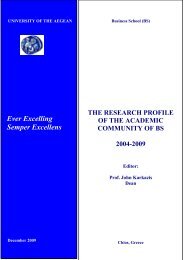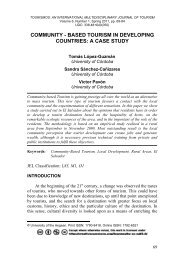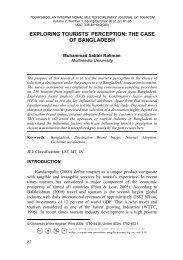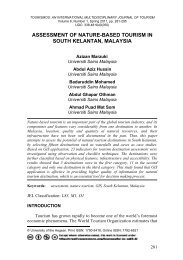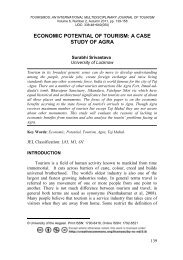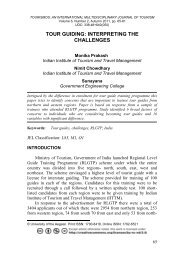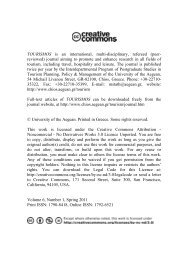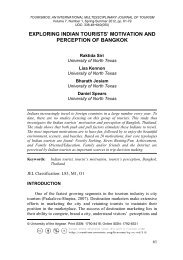GENDERED LEISURE: ARE WOMEN MORE CONSTRAINED IN ...
GENDERED LEISURE: ARE WOMEN MORE CONSTRAINED IN ...
GENDERED LEISURE: ARE WOMEN MORE CONSTRAINED IN ...
Create successful ePaper yourself
Turn your PDF publications into a flip-book with our unique Google optimized e-Paper software.
TOURISMOS: AN <strong>IN</strong>TERNATIONAL MULTIDISCIPL<strong>IN</strong>ARY JOURNAL OF TOURISMVolume 6, Number 1, Spring 2011, pp. 105-121UDC: 338.48+640(050)better status being given to females, the trend towards gender equality ison increase in all spheres of life, leading to blurring of gender differences.Nevertheless, it is still the developed industrialized societies that aremoving at a faster pace in reducing gender gap biases. In developingsocieties, it is the more educated, working and urban women who havemoved ahead to achieve a status equal to their male counterparts. Thesewomen are the ones who do not perceive any gender, familial or socialrestrictions as constraints. However, the picture of the uneducated, ruraland poor women still reflects subjugation.Over the years, travel for leisure (a sphere considered important byboth genders, for individual well-being and existence) has seen asignificant increase of female participation. Both as a market segment intheir own rights and by providing greater household funds fordiscretionary spending, women now are a significant force in holiday andbusiness travel (Bhatia, 2001). This is accounted for by a number offactors like, changing and progressive attitude of society towards femaleeducation, better jobs, elevated status, growth of independent workingwomen segment, late marriages, changing nature of ‘Ethic of Care’ andjoint sharing of familial responsibilities between the spouses. Tracingsuch changes, it can be concluded that though men retain their position ofthe advantaged gender experiencing lesser constraints in leisure travelchoices, nonetheless, women are no longer disadvantaged, but remain‘relatively’ more constrained. In view of the significant social changes,research needs to further explore changing gender relations in society thatcan determine whether any one particular gender will remain constrainedfor long in any sphere of life.REFERENCESAnderson, M.L. (1993). Thinking about Women: Sociological Perspectives on Sexand Gender (3 rd Ed.). New York, Macmillan Publishing Company.Apostolopoulos, Y. & Sonmez, S. (2001). Working Producers, LeisuredConsumers: Women’s Experiences in Developing Regions. In Y.Apostolopoulos, S. Sonmez and D.J. Timothy (Eds.) Women as Producersand Consumers of Tourism in Developing Regions, Connecticut: PraegerPublishers.Barff, R., Mackay, D. & Olshavsky, R.W. (1982). A Selected Review of Travel-Mode Choice Models. Journal of Consumer Research, Vol. 8, pp.370-380.Bartos, R. (1982). Women and Travel. Journal of Travel Research, Vol. 20, No.4,pp.3-9.117




